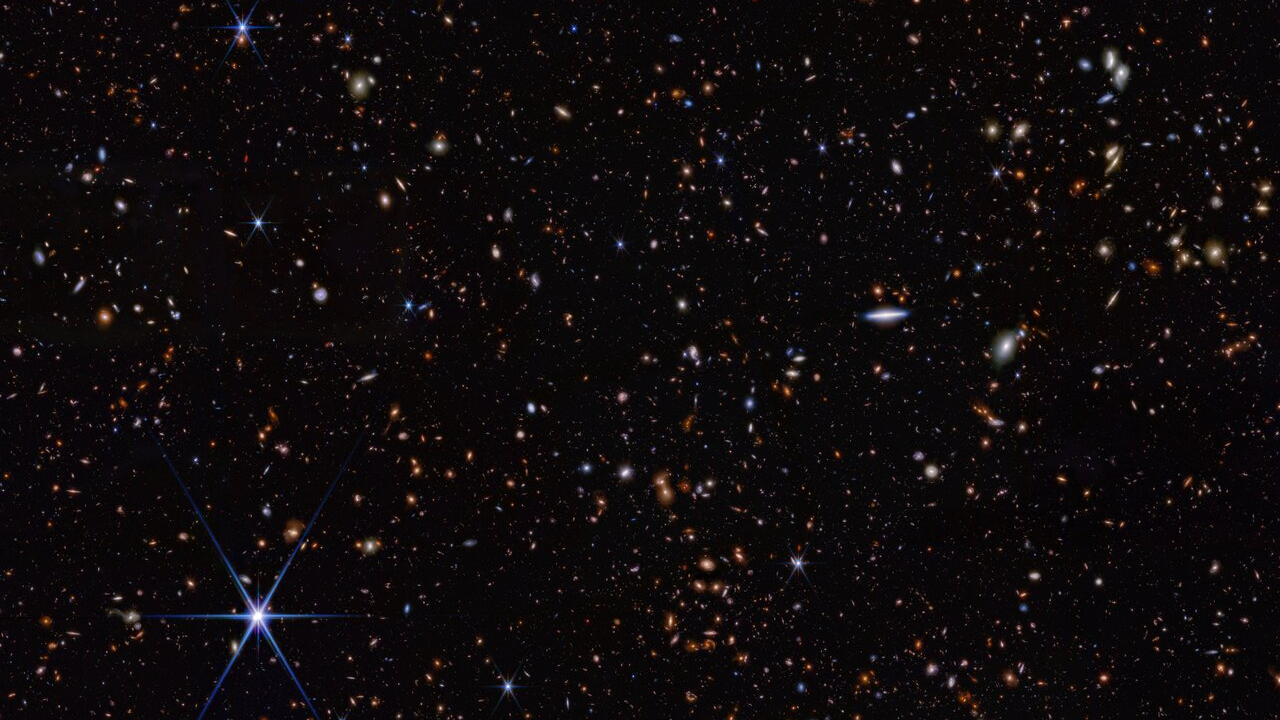
The most distant carbon ever seen has been discovered by the James Webb Space Telescope (JWST) in a galaxy that we see as it existed just 350 million years after the Big Bang.
The detection is notable because not only is it the oldest carbon known, it is the first time that an element heavier than hydrogen or helium — what astronomers call "metals" — has been confirmed in the very early universe.
"Earlier research suggested that carbon started to form in large quantities relatively late — about one billion years after the Big Bang," Roberto Maiolino, of the Kavli Institute of Astronomy at the University of Cambridge in England, said in a statement. "But we've found that carbon formed much earlier — it might even be the oldest metal of all."
Related: What is the Big Bang theory?
The hydrogen and helium in the universe was born in the furnace of the Big Bang, but other than an additional smidgen of lithium, every other element had to wait to come from stars. Nuclear fusion reactions inside those stars create carbon, oxygen, nitrogen and so on, while the raw energy of a supernova blast can create many other, even heavier, elements, as can neutron-star mergers.
Many of these elements, particularly carbon, are crucial for forming planets and life as we know it, but it took many generations of stars for enough carbon and other metals to build up to be detectable at such great distances and to be useful in cosmic chemistry.
However, the JWST's detection of carbon in the galaxy GS-z12 — which is found at a redshift of 12.5, equating to a look-back time of 13.4 billion years — suggests that stars lived fast during the cosmos' formative years. Many generations must have come and gone in rapid succession in order to build up detectable amounts of carbon in such a short time. (The Big Bang occurred about 13.8 billion years ago.)
"We were surprised to see carbon so early in the universe, since it was thought that the earliest stars produced much more oxygen than carbon," said Maiolino. "We had thought that carbon was enriched much later, through entirely different processes, but the fact that it appears so early tells us that the very first stars may have operated very differently."
GS-z12 is a compact, low-mass galaxy compared to our own Milky Way but is relatively massive for the early time frame that we find it in, an era that was populated by small but rapidly growing galaxies.
"It's just an embryo of a galaxy when we observe it, but it could evolve into something quite big, about the size of the Milky Way," said the Kavli Institute's Francesco D'Eugenio, who led the research.
The discovery of carbon so early potentially changes what we know about the course of cosmic chemistry. Carbon is an essential component of cosmic dust grains, which clump together to build larger objects — asteroids, planetestimals, and finally planets themselves. Indeed, it is believed that Earth was assembled mostly from carbonaceous objects. Carbon is also a vital component of life as we know it.
"The very first stars are the holy grail of chemical evolution," said D'Eugenio. "Since they are made only of primordial elements [i.e hydrogen and helium exclusively], they behave very differently to modern stars. By studying how and when the first metals formed inside stars, we can set a time frame for the earliest steps on the path that led to the formation of life."
The JWST's Near-Infrared Spectrometer (NIRSpec), which detected the carbon, also found hints of oxygen and neon in GS-z12, but more data is required to confirm the existence of these elements.
While the carbon in GS-z12 is confirmed as the earliest metal, the galaxy may not hold the record for very long. Astronomers using the JWST have found what appears to be the highest redshift galaxy discovered to date, at a redshift of 14.2, which places it at just 290 million years after the Big Bang. The absorption line of oxygen has been detected in its spectrum, but that discovery still needs to be rubber-stamped via peer review. Once it has been published in a journal, then that will become the earliest example of an element heavier than hydrogen or helium.
Either way, the new find shows that elements could be produced in significant quantities in the early universe and that, back then, stars lived and died faster than astronomers realized.
Furthermore, the presence of carbon and oxygen in the early universe means that astronomers and astrobiologists can perhaps start talking about the existence of planets and maybe life earlier in the universe too.
The discovery of carbon in GS-z12 is to be published in a future issue of Astronomy & Astrophysics, but a preview of the paper is available here.







